- Home
- Blog
- Web Design The Best CSS Reset Stylesheets
The Best CSS Reset Stylesheets
-
 6 min. read
6 min. read
-
 William Craig
William Craig CEO & Co-Founder
CEO & Co-Founder
- President of WebFX. Bill has over 25 years of experience in the Internet marketing industry specializing in SEO, UX, information architecture, marketing automation and more. William’s background in scientific computing and education from Shippensburg and MIT provided the foundation for MarketingCloudFX and other key research and development projects at WebFX.
Resetting your CSS to baseline property values is useful for gaining control, predictability, and uniformity with regards to how browsers render your HTML elements. To learn about CSS resets in greater detail, see these articles:
If you’re looking for a stylesheet to help you reset your CSS, in my opinion, these are your top options right now:
Reset CSS
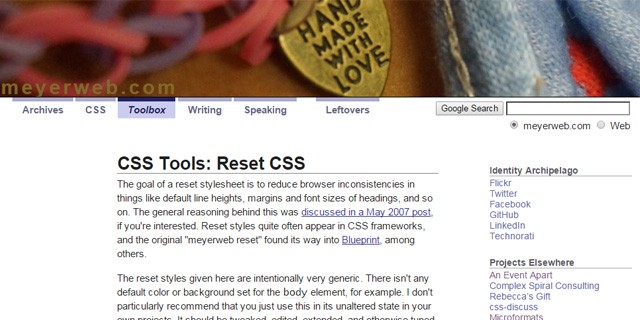 Eric Meyer’s Reset CSS — this is the stylesheet that made CSS resets a mainstay. Reset CSS either nullifies a default CSS property by setting it to 0, or it sets the property to a common-sense value (e.g.,
Eric Meyer’s Reset CSS — this is the stylesheet that made CSS resets a mainstay. Reset CSS either nullifies a default CSS property by setting it to 0, or it sets the property to a common-sense value (e.g., line-height: 1 on the <body> element). Explicitly declaring certain CSS property values can help reduce inconsistencies in the way our HTML elements are rendered by the browser.
Related:Eric Meyer’s thoughts on CSS3 Note that Reset CSS was last updated in 2011. Many CSS reset stylesheets we’ll be talking about haven’t been updated in a while.
HTML5 Reset Stylesheet
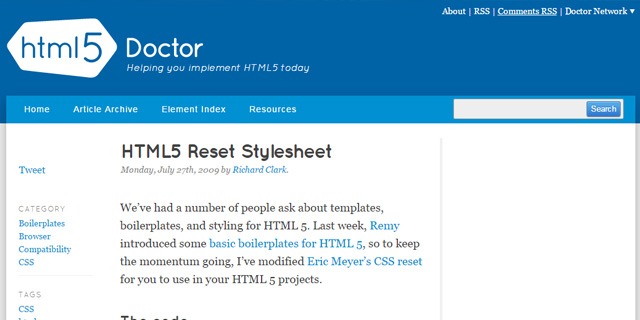 This reset stylesheet by Richard Clark is a modification of Eric Meyer’s Reset CSS. This CSS reset is geared towards modern HTML 5 elements.
This reset stylesheet by Richard Clark is a modification of Eric Meyer’s Reset CSS. This CSS reset is geared towards modern HTML 5 elements.
Other tweaks found in HTML5 Reset Stylesheet are the removal of a :focus pseudo-class reset and the use of attribute selectors to target the <abbr> and <dfn> elements in a way that minimizes the scope of their style rules.
CSS Mini Reset
This is a minimalist CSS reset by Vladimir Carrer. It only has four CSS style rules.
It only resets the most frequently-used HTML elements — the ones you’ll actually use in your web development projects. Check out CSS Mini Reset on GitHub.
reset.css (from HTML5 Reset)
This stylesheet is part of the HTML5 Reset boilerplate.
Its inception was inspired by three open source projects: Reset CSS, HTML5 Reset Stylesheet, and HTML 5 Boilerplate. This reset stylesheet is robust and opinionated. For example, it has specific style rules for the :before and :after pseudo-classes and it sets the box-sizing property to border-box, which your other options don’t do.
Marx
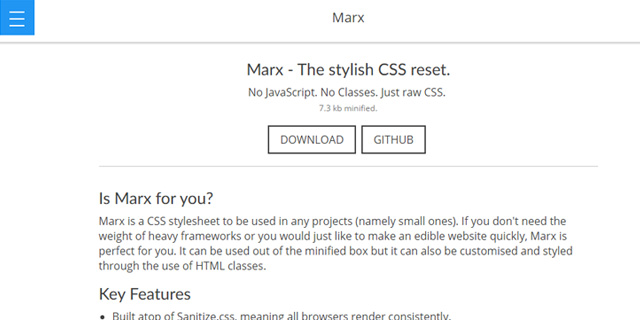 This CSS reset is a boilerplate stylesheet for small website development projects. For simple websites, such as one-page sites, you most likely don’t need to use a big front-end framework like Bootstrap. In these cases, Marx is an option to consider.
This CSS reset is a boilerplate stylesheet for small website development projects. For simple websites, such as one-page sites, you most likely don’t need to use a big front-end framework like Bootstrap. In these cases, Marx is an option to consider.
Specialized CSS Resets
These two CSS reset stylesheets are purpose-specific:
Typeset.css
This is a baseline CSS reset just for Web typography. It’s geared towards text-heavy sites and web pages, such as blogs and news sites. Note that Typeset.css will only work on HTML elements that are the children of an element with a class of typeset.
So to implement Typeset.css, you’d need to do something like:
<div class="blog-post typeset"> <h1>Blog Post Title</h1> <p>My blog post.</p> </div>Cleanslate
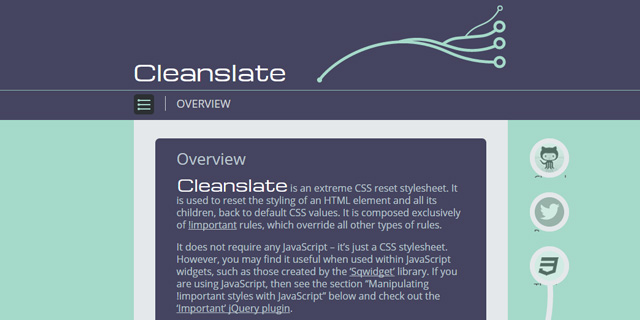 This CSS reset stylesheet is extremely aggressive. It’s designed for use on content that will be distributed on another website, a scenario where your control over style rules is restricted. Cleanslate uses an
This CSS reset stylesheet is extremely aggressive. It’s designed for use on content that will be distributed on another website, a scenario where your control over style rules is restricted. Cleanslate uses an !important declaration on all property values to force browsers not to follow normal cascading and CSS specificity rules.
This gives you a fighting chance when it comes to overwriting the style rules of the third-party website.
CSS Normalization: A Modern Alternative
Browsers today are pretty good at setting appropriate default styles. Also, they now abide by modern standards and best practices.
Default styles are now more predictable and consistent across the board. So, instead of doing a blanket reset on all the default browser styles, we can instead focus only on specific HTML elements and CSS properties that aren’t being rendered uniformly in different browsers. We keep the other useful browser defaults.
That’s the main idea behind CSS normalization. In other words, for our unstyled HTML elements, we implicitly let the browser or the normalization stylesheet set the style rules for us. This way, if we forget or don’t assign a style rule to an element, they will still render predictably and consistently across the various browsers.
One benefit of CSS normalization is it keeps our stylesheets DRY. We aren’t resetting an HTML element’s property values to 0, only to overwrite the property declarations farther down the cascade with another style rule. Related:Should You Reset Your CSS? Here are the top two CSS normalization stylesheets to check out:
Normalize.css
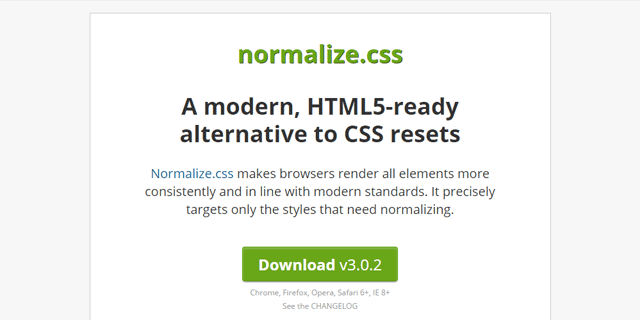 This popular CSS normalization stylesheet is used in major sites like Twitter and GitHub, and is a dependency in big open source projects like Bootstrap and HTML5 Boilerplate.
This popular CSS normalization stylesheet is used in major sites like Twitter and GitHub, and is a dependency in big open source projects like Bootstrap and HTML5 Boilerplate.
Normalize.css is the one that started it all.
sanitize.css
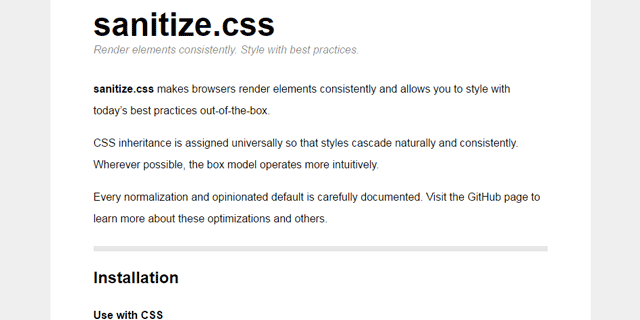 This CSS normalization stylesheet is by Jonathan Neal, the co-author of Normalize.css. sanitize.css has style rules that will help you render HTML elements consistently in different browsers.
This CSS normalization stylesheet is by Jonathan Neal, the co-author of Normalize.css. sanitize.css has style rules that will help you render HTML elements consistently in different browsers.
This normalization stylesheet has a Sass version, which many developers will appreciate.
Further Reading
- What Is A CSS Reset?CSS Reset
- What is the difference between Normalize.css and Reset CSS?Stack Overflow
Related Content
- 12 Common CSS Mistakes Web Developers Make
- Resetting Your Styles with CSS Reset
- 100 Useful CSS Tips and Tricks
 Jacob Gube is the founder of Six Revisions. He’s a front-end developer. Connect with him on Twitter.
Jacob Gube is the founder of Six Revisions. He’s a front-end developer. Connect with him on Twitter.
-
 President of WebFX. Bill has over 25 years of experience in the Internet marketing industry specializing in SEO, UX, information architecture, marketing automation and more. William’s background in scientific computing and education from Shippensburg and MIT provided the foundation for MarketingCloudFX and other key research and development projects at WebFX.
President of WebFX. Bill has over 25 years of experience in the Internet marketing industry specializing in SEO, UX, information architecture, marketing automation and more. William’s background in scientific computing and education from Shippensburg and MIT provided the foundation for MarketingCloudFX and other key research and development projects at WebFX. -

WebFX is a full-service marketing agency with 1,100+ client reviews and a 4.9-star rating on Clutch! Find out how our expert team and revenue-accelerating tech can drive results for you! Learn more
Make estimating web design costs easy
Website design costs can be tricky to nail down. Get an instant estimate for a custom web design with our free website design cost calculator!
Try Our Free Web Design Cost Calculator


Web Design Calculator
Use our free tool to get a free, instant quote in under 60 seconds.
View Web Design CalculatorMake estimating web design costs easy
Website design costs can be tricky to nail down. Get an instant estimate for a custom web design with our free website design cost calculator!
Try Our Free Web Design Cost Calculator





